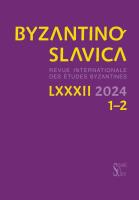Greek Philosophical and Logical Terms in the 10th c. Preslav Translations
Greek Philosophical and Logical Terms in the 10th c. Preslav Translations
Author(s): Ivan ChristovSubject(s): History of ideas, Middle Ages, Historical Linguistics, Philosophy of Language, Philology, Translation Studies
Published by: AV ČR - Akademie věd České republiky - Slovanský ústav and Euroslavica
Keywords: Preslav School; Byzantine Logic; Slavonic Terminology; Translation Consistency; John the Exarch; Tzar Simeon;
Summary/Abstract: The article examines the translation of Byzantine texts with logical content in the Preslav School in the 9th and 10th centuries. The way in which 90 Greek terms are rendered, referring to the ontological foundations of logic and above all those with a specific logical meaning, is studied. Slavonic equivalents related to terms in proposition and their hierarchy, propositions themselves as bearers of truth and falsity, logical operations, syllogism and definition are put to examination. There was no norm at that time and the Preslav translators put immense effort to render these most complex and unusual texts. Completely understandable under these circumstances they were not always consistent in word usage. That is why the Preslav translators used 204 Slavonic words and word combinations thus more than doubling (226%) the terminology of translation. A comparison is made of the practice of translation within the school and sceptical remarks are made about the existence of a unified, preconceived and agreed upon register of terms in it. The grounds for this are that out of 42 logical terms in John the Exarch, only 16 match those in the Miscellany of Tzar Simeon and out of 57 terms in the Constantine of Preslav’s translation of the orations against the arians by Athanasius of Alexandria, also only 16 match those in the Miscellany of Tzar Simeon and in the translations by John the Exarch. The article also studies the question of the persistence of the tradition and compares the first translations of the 9th and 10th centuries with those of the “Dialectic” by John Damascene and the “Areopagitics” in the 14th c. It is concluded that the Serbian translators of the 14th c. were quite independent from their Preslav predecessors using only 59 of their terms (29%) and have introduced 138 new ways of rendering the Greek originals. This testifies to the limited uniformity of Slavonic philosophical tradition through the centuries. Therefore, the applicability of Preslav translation forms today needs a conscious appreciation and balanced approach. In this way it can be recognized and properly appreciated.
Journal: Byzantinoslavica - Revue internationale des Etudes Byzantines
- Issue Year: LXXXII/2024
- Issue No: 1-2
- Page Range: 150-173
- Page Count: 24
- Language: English
- Content File-PDF

